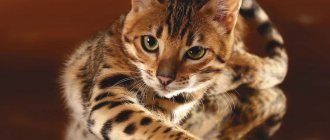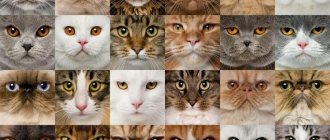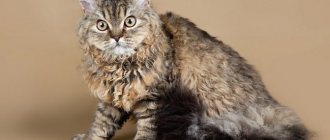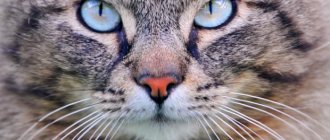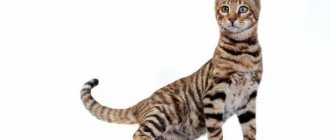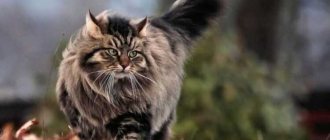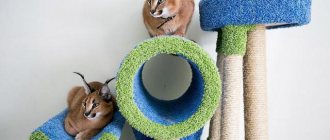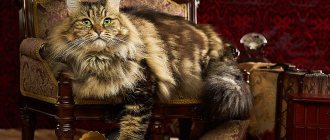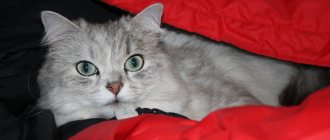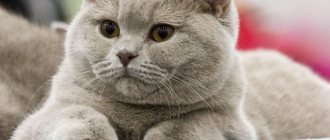Tabby cats are especially loved and most popular among furry pet lovers.
By the way, according to biologists, it is this color that makes cats cats. And indeed, if you turn your attention to the animal world, you will never see tiger stripes on anyone else. And according to popular belief, mustachioed and striped animals bring good luck to the house and make the owners more resilient in the face of life’s difficulties. A tabby cat fills the house with comfort and warmth
Genetics of tabby cat color
Tabby color, i.e. The coat pattern, of which the mackerel (tiger, striped) is a subspecies, is caused by the dominant T gene (Tabby), located on chromosome 1B. Of all the mammals living on our planet, it is characteristic only of the cat order.
This color is also called wild, since the very first cats on earth had it. It is characterized by the fact that darker spots and lines are located on a light background.
There are four types of such colors based on the phenotype of the dominant gene (allele):
- Tm - tiger pattern or mackerel, i.e. pure striped;
- Tb - marbled color, classic;
- Ta - agouti, ticking (in Abyssinian cats);
- Spotted Tabby (spotted tabby) - a spotted pattern, this is a polygenic color, a combination of several genes is responsible for it.
All cats, without exception, are carriers of the T gene, but if a recessive gene that blocks ticking (non-Agouti) is present in the animal’s phenotype, then the stripes are not visually visible.
“Not purebred” or non-standard genotype
The appearance of an unborn yard kitten is very difficult to predict, because it is born from a mixture of two or even several breeds. Therefore, color, coat length, eye color and other characteristics are always a pleasant surprise.
Breeds of yard cats are varied. The variety of coat colors of mongrels can be the envy of any exotic purr participating in championships. This can be a single coat color or a combination of two or even several shades. The patterns and markings on the base color also vary. A common color is dark stripes on a light background. It is this pattern that helps the animal camouflage itself in natural conditions and hunt successfully.
The fur of yard cats can be long or short, but what you definitely won’t find is the complete absence of fur on the animal.
The mongrels are in most cases medium in size, and their weight ranges from 3 to 6 kg.
The character of yard cats, unlike purebred cats, is varied. They are not characterized by aggression and touchiness. They generally show emotions very carefully.
Mustachioed mongrels love active games and appreciate the attention of household members. They can become attached to someone in particular or love everyone with the same love at the same time.
These cats have a negative attitude towards the absence of their owners and can even fall into a kind of “cat” depression. This is manifested by refusal of food, hair loss, etc. But this condition mainly applies to “apartment” cats that cannot freely go outside.
Norwegian forest
A large, strong, muscular, very agile cat in a luxurious, very dense coat with water-repellent outer hair covering the back, sides and tail. Breed standards allow many colors, but tabby is one of the most common and, admittedly, the most “suitable” to their harsh appearance.
The ancestors of the Norwegians are feral domestic cats, inhabitants of the forests of Scandinavia for hundreds of years. How they got to those harsh lands is not known for certain. Research has only proven their relationship with Turkish Angoras.
The Norwegian Forest cat is not an old breed, although ideas about its selection appeared back in the 30s of the last century - when it became obvious that the cats of the Scandinavian forests were in danger of extinction. But the breeding program was developed only in the 70s, and was quite successful. Now Norwegians are recognized throughout the world and are the pride of Norwegian breeders (hence the name).
Asian tabby
The name of this breed is more eloquent than any comments. The animal belongs to the Asian group of cats, and its coat is striped.
The breed arose at the end of the 19th century as a result of crossing the Burmese and the Persian chinchilla. It was recognized only a century later.
She has a strong body with a broad chest and powerful shoulders. The rounded head is slightly elongated into a blunt wedge. The almond-shaped eyes have a golden hue. The Asian tabby is a short-haired breed. The pet's weight is 4-7 kg.
This cat is distinguished by its devotion and, at the same time, unobtrusiveness. They love games and are not averse to lying in the arms of their owner. These are intelligent cats, they are followers of an active lifestyle. Their character is flexible and soft.
Feature of striped color
In order for a cat to be tabby, in addition to the tabby gene, its chromosome set must also contain the Agouti ticking gene. In all such cats, each hair is colored in several dark and light shades, arranged in alternating patterns. Visually, this is perceived as lines and spots on the coat.
All ginger cats must have a striped pattern. The red color gene O, linked to the male chromosome X, suppresses the action of the recessive non-Agouti gene.
The tabby pattern can be tortoiseshell (tortie) cats and color-point animals.
Recent scientific research conducted by the famous geneticist Stephen O'Brien has led to the conclusion that the dominant T gene and the cat's immune system are related.
“A tabby is not a simple set of stripes and spots, it plays a more important role in a cat’s body” - this statement by the scientist formed the basis for his study of the relationship between tabby and animal immunity at the Scientific Center for Genomic Bioinformatics in St. Petersburg.
A distinctive feature of tabby cats is the letter “M” on their forehead. There is a biblical legend that it means the name of the Virgin Mary, since the mother of Jesus Christ stroked the head of the kitten lying next to her in the stable of Bethlehem on the night of the birth of the son of God.
Muslims believe that this is the first letter of the name of the Prophet Muhammad, since he loved cats very much.
Why are tabby cats so popular?
According to some researchers, tabby cats walked the earth in those distant times when they could only interest humans as prey. Perhaps they are the ancestors of modern representatives of the cat family.
The most common color is camouflage
One of the Arab legends tells about a cat who fell asleep on the sleeve of the Prophet Muhammad. Instead of waking up and driving away the animal, the prophet, going to pray, cut off his sleeve so as not to disturb the sleeping woman. Later, the cat thanked Muhammad by warning about the danger, for which she received his blessing. So the letter “M” appeared on the animal’s forehead, and on its body, in those places that the prophet touched, dark stripes appeared.
For your information! The ancient Egyptians believed that the letter "M" in a cat's forehead was a symbol of the sacred scarab beetle. Catholics believed that the stripes were a memory of the blessing of the Virgin Mary. They appeared after the cat killed a poisonous snake sent to bite the baby Jesus. Having dealt with the reptile, the cat curled up in the cradle to prevent the little Savior from freezing.
Kurilian Bobtail
A compact, muscular cat, with a slightly arched back, longer hind legs and a short (3 - 8 cm) twisted tail, which, due to its longer fur, has the appearance of a lush pom-pom. The wool is thick, with good water-repellent properties, but a weak undercoat. There are two breeds of Kurbobs, which differ only in the length of their coat. These are sociable, inquisitive, but independent cats, playful and affectionate.
As the name suggests, the breed has some relation to the Kuril Islands. It was there that the ancestors of the Kurbobs lived (and still live). At one time it was assumed that the gene for short-tailed cats living in the Kuril Islands is identical to the gene for Japanese bobtails, a long-existing breed. This version was logical, because Japan is very close. But then it turned out that this was not the case, and cat fans have the opportunity to admire another bred breed.
Appearance
In accordance with the standards, the Whiskas color has received the right to combine the colors of British fur coats that have any pattern. The following characteristic elements must be present:
- there should be a pattern on the cat’s forehead that follows the outline of the letter “M”;
- the back surface of the ear should have a light spot resembling a fingerprint in outline;
- The animal's eyes and nose should be outlined with fur of the primary color.
striped british
In order not to make a mistake with your choice, you need to inspect the animal’s fur coat. The main color is silver (mackerel). Stripes can be of any shade. But the back is always decorated with the three widest stripes that run along its entire length. The remaining stripes are located throughout the fur coat, only thinner.
Related colors are spotted and merle. But a true British tabby cat should have a silver coat, decorated with stripes ranging from dark gray to black.
The animal's chest should be decorated with a necklace of closed stripes. The paws and tail should also be decorated with closed rings. In this case, all stripes should be clear and clearly visible. The coat should have a rich shade.
TOP 14 most striking representatives of the striped color
Almost all cats are tabbies, except for breeds that have a solid or solid color. These are Chartreuse, Russian Blue, Nibelung, Bombay cat, Balinese and some others. There are breeds that are bright representatives of the striped color.
Toyger
This breed is essentially a subspecies of the Bengal. For a Bengal cat, the merging of spots into continuous stripes is unacceptable and serves as grounds for disqualification.
The consolidation of this culling factor led to the formation of a new cat variety with a brindle pattern. In English-speaking felinology it is called mackerel.
This strong and energetic pet is no different in personality from the Bengal.
Read more in the article about toygers.
European Shorthair
Celtic cat is the second name of the breed. This naturally occurring variety has a strong, muscular body. He has a calm and friendly character. It is undemanding in maintenance and care.
Siberian cat
Animals with a strong and powerful body and a luxurious fur coat with undercoat are carriers of a very healthy immune system. This natural breed was formed in Siberia over many centuries.
Wonderful hunters and home protectors with a variety of numerous colors are always tabbies. They are distinguished by stripes on the paws and tail, round spots on the stomach and a clearly drawn letter M on the forehead.
By nature, these are very calm and serious animals that do not like excessive care. Long hair requires some care, especially during the shedding period.
Read more in the article about Siberian cats.
American Shorthair
These cats, which descended from their European counterparts, came to America with the first settlers. Adapting to new, harsh living conditions, the animals became larger in size and stronger, more muscular. The American coat is coarser and denser, with a well-developed undercoat.
The colors are varied - solid, shaded and tabby. The most famous, beloved and widespread type is the American cat with a classic marbled color.
These sociable but independent pets adapt well to any living conditions. They are smart and easy to train. They obey their household members and consider it their duty to care for and protect everyone living in the house.
The short and dense coat requires virtually no maintenance. The health of these cats usually does not cause any concern to owners.
Also read the article about American Shorthair cats.
Bengal
These hybrid animals always carry the Tm or Tb allele. Polygenic combinations produce the spotted tabby color. All cats have bright stripes and spots on their bodies, paws, tails and bellies. In this case, the main background can be different - gold (red), silver (gray), white (snow colors), black (black).
Bengal is a very mobile and active animal. Attached to the owner, an eternal child who will play all his life. Suffering from loneliness.
If it is not possible for one of the household members to always be in the house, then it is better to get another pet with the same lively and restless character.
The Bengal owes its dazzlingly beautiful coat with soft shiny fur to its wild ancestor - the Asian leopard cat (or Lesser Asian leopard). ALC, along with Ocelot and Margay, is the most striking representative of the tabby color in the world of wild cat species.
American Bobtail
The breed originated in the United States of America. Her ancestor was a homeless tabby kitten from the Arizona Indian Reservation.
These short-tailed animals come in different colors and types, but the tabby pattern remains the most common and beloved.
The character of the pets is calm and flexible. At the same time, they retain their love of freedom and independence. Smart, intelligent, even trainable. They are unpretentious in care and nutrition.
Read more in the article about American Bobtails.
Cymric
The long-haired beauty is distinguished by complete taillessness and a strong, muscular, fairly large body.
The double coat has a powerful undercoat, so the animal visually appears even larger. Comes in various colors. But tabby coloring is the most widespread.
These hardy, loyal and affectionate animals will never allow themselves to offend children. They are one of the best breeds for home keeping.
More about the Cymrics.
Soukok or sokoke
A small cat with a dry type of muscles is the bearer of a special unique color, which is called “soukok-tabby”.
This natural breed was discovered in Kenya, in the town of Soukok.
The color variations of the wool are varied, but the pattern is always marbled, in the form of large rings and “rosettes” of various sizes.
As a domestic variety, it is still a very young breed. Only twenty animals are registered in the fifth generation.
Good-natured pets are very active, cheerful and restless. Lovers to “talk” and play, are very smart and independent. They get along well with everyone, but it is better to have a cat of the same breed as a companion. They need large spaces to play and love to swim.
Read more in the article about the Sokoke breed.
Maine Coon
A native breed from the American state of Maine, it is distinguished by its large size, long, dense coat with a well-developed undercoat and independent character.
There are many legends about the origin of the variety. Maine Coon literally means “raccoon from Maine.” The second most popular breed in the United States.
The colors of the long coat can be different - solid, smoky, tortie and tabby. Although there are experiments on breeding coons and color-point colors, the so-called Si-coons.
These animals are calm, reserved, self-confident, independent, but good-natured. They require daily care and increased attention to health.
Norwegian forest
A strong and robust animal with a characteristic and recognizable body shape. Good health, excellent muscles and a long double coat with water-repellent properties are what allowed this cat to survive and adapt to the harsh Scandinavian climate.
This is the only cat that can climb down a tree trunk with its face; no other domestic breed has such powerful claws.
Tabby is one of the most common colors of the Norwegian.
The character is calm and reserved. The animal does not tolerate loneliness well and becomes strongly attached to humans.
Exotic
The exotic cat's body structure is completely reminiscent of the Persian. This breed was bred as its short-haired variant.
Among the many colors of Exot, tabby is very popular and loved.
These calm and unpretentious animals are generally recognized throughout the world as the most affectionate and loyal. The best pet option for families with children.
Asian tabby
The breed was artificially bred in the 1980s. The color of the coat can be different - black, red, chocolate, blue, cream, lilac, caramel, apricot. But the color is only tabby.
Calm and good-natured pets are very sociable and devoted to people. They get along well with any animals and are quite silent.
Pixiebob
This young variety is gaining worldwide popularity every year. First of all, because of his wonderful character. Although the exotic appearance also matters.
Pixie means “fairy-tale elf” - that was the name of the first representative of the breed. Bob - short ponytail.
These are animals with the appearance of a lynx and the character of an angel.
Active and energetic pets are completely unobtrusive and at the same time pathologically devoted to their owner. Very smart, inquisitive and sociable. They can easily learn to perform simple commands.
Read more in the article about pixie bobs.
British breed
British dogs come in different colors - both solid and tabby. Striped colors are very diverse in their color variations. They are divided into marbled, brindle and spotted (spotted) type according to the nature of the pattern.
Cats have the character of true English lords, they are very reserved, independent and proud.
We also recommend reading the article about British shorthair, longhair and fold cats.
History of the American Shorthair cat breed
American Shorthair
Unfortunately, this legend is not documented, which cannot be said about the widespread version of the origin of the breed. The first cats, which may have become the ancestors of the “Americans,” appeared in the New World at the beginning of the 17th century along with a group of English Protestants. They arrived in America on the Mayflower and founded Jamestown, the first British settlement. This is evidenced by entries in journals that have survived to this day since 1609.
Once in a different climate, animals were forced to adapt to new living conditions. The size of cats has increased in comparison with their European counterparts, and their fur has become stiffer and thicker. While whiling away their days on farms and ranches, near houses and barns, the ancestors of American Shorthairs could increasingly boast of good health
The settlers noticed this and soon began to value the “stability” of the animals along with their excellent skills in exterminating rodents
Until the beginning of the 20th century, breeding of cats took place in free conditions: no one cared about the exterior and purebred pedigree, or made any attempt to standardize the breed. The ancestors of the “Americans” retained similarities with their British relatives, but were distinguished by a more elongated and athletic physique. In addition, the animals were hardy, intelligent and fearless, which made them valuable material for breeding. Soon, US breeders realized that they needed to preserve the breed. Thus began the breeding of American Shorthair cats.
American shorthair kitten
Fans of these amazing animals began to acquire outstanding representatives of the breed and form ideal breeding pairs. This would allow the cats to maintain their remarkable appearance and docile nature. In 1904, the CFA registered Buster Brown, a direct descendant of the “British” who came to the United States with the colonists. From that moment on, American breeders developed a clear cat breeding program.
Its results became clear by 1930, when, with a relatively small number of generations, it was possible to “enrich” the breed with many remarkable colors. Among them was silver – a legacy from the Persians. Breeding American Shorthair cats also played an important role in the lives of their brothers. With the participation of these animals, it was possible to create new breeds: Snowshoe, Bengal, Scottish Fold, Ocicat, Bombay, Devon Rex, Exotic, Maine Coon, etc.
Best articles: What animals live in Asia - list of species, photos and characteristics
In the middle of the 20th century, CFA members published the first catalog, which included about fifty representatives of the breed. At that time she was known as a domestic shorthair. Under the same name, the animals first participated in the 1966 exhibition. Shawnee Trademark won, inheriting the title of “Cat of the Year.” At the same time, they decided to rename the breed in order to reflect its true “American” character and thereby separate it from its other short-haired counterparts. Despite this, cases of cats being registered under the previous name occurred until 1985.
American Shorthair cats love to lie around and sleep, that is, they are quite lazy
In 1984, the handsome Mr. H won a similar victory, and in 1996, Sol-Mer Sharif. The end of the 20th century was significant for representatives of the breed. Over the course of two decades, American shorthair cats have gracefully climbed to the top of the rankings of the most popular breeds and have chosen a place in the top ten shorthair favorites in the United States.
The CFA organization has about a hundred registered kennels that specialize in breeding this breed. Moreover, most of them are concentrated in America: breeders have entrusted their national treasure to a few. The history of American shorthair cats in Russia began in 2007 with the appearance of a breeding pair - the cat Lucky and the cat Cleopatra, brought from the KC Dancers cattery.
Official nurseries can boast of worthy producers originally from the USA. Despite the few litters of American Shorthairs, representatives of the breed are becoming more and more common
Russian breeders are working hard to ensure that these cats take an important place in people’s hearts and subsequently win as many victories as possible at specialized exhibitions. So far these are just dreams: the European “cat” organization FIFe still does not officially recognize short-haired “Americans”
Representatives of this breed are found less frequently in Russia than, say, in Japan.
Character of outbred minke whales
The behavior of representatives of certain breeds is directly related to their roots and heredity. What then is the character of the ordinary tabby cats that live in our yards and, of course, in apartments?
Overall, a simple gray tabby cat can be a real test of strength. He is extremely inquisitive, independent, cheerful and active. And the mixture of these qualities speaks only of one thing - you shouldn’t expect much peace from such a pet. But at the same time, this cat is very smart and understanding, and some prefer to defend their point of view, entering into an argument with the owner and repeating the same act over and over again.
Tabby cats can hardly be called obedient, but at the same time they accept punishment with understanding and never take revenge for fair punishment. But it is useless to conduct educational conversations with such pets - for some time they will look you in the eyes with a smart look and show that they understand everything and are aware of how bad the action was, but after a few seconds they will turn around, cutting off your tirade mid-sentence.
Instructions and rules are not for a tabby cat - she always does what she considers necessary
All owners of tabby cats know that their pets are always mischievous and under any circumstances. However, they are endlessly cute and are characterized as extremely cheerful animals. You are guaranteed not to get bored with your striped pet, but you should remember that he easily gets excited, and therefore it is important to stop him in time. Otherwise, too much activity can lead to unpleasant consequences, such as torn wallpaper, tulle torn from the cornice, etc.
The tabby cat rests wherever she pleases. And even if you buy her the most beautiful and comfortable house, it is far from a fact that she will sleep in it. Such a pet chooses its own place to rest; it could be your favorite chair, your sofa or a pillow on your marital bed. And once a tabby cat makes its choice, it is extremely difficult to retrain it. You come to bed, carefully carry your seemingly asleep pet to a place specially designated for him and lay down in your bed, fall asleep... open your eyes, it’s the middle of the night, and your pet is snoring peacefully under your nose, as if he never left.
Games... tabby cats can spend an infinite amount of time on this. But don’t rush to buy your pet any special balls, colored mice or other expensive teasers. They prefer to play with the simplest things: pencils, fallen leaves from a flower on the windowsill, apples that you just left in the kitchen, as well as cups and even plastic bags. Tabby cats are quite picky in this regard and are capable of chasing the chestnut you brought from the street around the apartment for hours on end, and completely not paying attention to expensive toys. Believe me, the latter will most likely constantly gather dust in the corner.
On a note! However, here you should remember that flower pots will often end up on the floor, and ballpoint pens will begin to disappear without a trace from your desktop!
Type of drawing and character of the cat
Tabby patterns are divided into several types. Each of them is not capable of duplicating one to one. But there are always common points. Signs by type:
Ticked
A wild cat will be ticked faster. There are marks not only on the body, but also on the tail and limbs. But this is not the peculiarity: each hair will be different colors at the same time.
Ticked tabby
Spotted
Cats with this color have stripes and curls of different shapes. More like a broken straight line. It combines two types at once: brindle and classic, but all the lines are broken.
Spotted color
Classic marble
The peculiarity of the color is that there are curls resembling eyes on the sides. All lines are thick and large. Not interrupted. Clearly throughout the body. The back of the head and shoulders also have lines. Their shape resembles the image of a butterfly.
Classic marble color
brindle
Many breeds can boast that their bodies are striped, but narrow. The predominance of such marks is on the body. The paws and tail are covered with bracelets, and there is a necklace on the sternum.
Brindle color cat
Based on the colors and types, many cat owners calmly judge the character of their pet. Heredity is not so important here as curls, color and their shape. Even excellent parenting will not be able to break the character inherent genetically. Thus, according to the observations of breeders and workers of homeless animal shelters, cats with tortoiseshell markings are temperamental and the difficulty in communication is very pronounced. With white marks and their predominance, cats are of a calmer disposition and are able to calm anyone they get into their arms. As for saffron milk caps, the energy simply emanates from them is so powerful that it energizes the owner. At the same time, they are distinguished by their explosive nature. Quite arrogant cats and vindictive.
Wild roots
The color called tabby is considered one of the very first. One might even say, pure. It was “carried” by wild cats. Allows you to camouflage among trees and remain invisible for a long time. This is the only way to catch a bird or small animal. The same color allows you to be unnoticed in the grass and bushes, as if in “camouflage”. Tracking a cat with this color is extremely difficult. Since the roots are ancient, the character is complex and is imprinted on pets of all breeds with it:
- excellent hunters;
- immunity is especially well developed;
- dexterous;
- almost never cause allergies;
- active.
The color called “tabby” is considered one of the very first
While the individual is in childhood, playfulness comes first. But the older the cat gets, the more measured the cat becomes, calmer and more independent.
"Classics of the genre
If the owner is not particularly concerned about finding a rare, original name for his mustachioed-striped pet, then you can limit yourself to a list of the most common cat names:
- Barsik;
- Boris;
- Vaska;
- Basil;
- Kuzya;
- Kuzma;
- Kotofey;
- Marquis;
- Murzik;
- Semyon (Semka, Semushka);
- Stepan (Styopka, Stepashka);
- Timofey;
- Timka;
- Tishka;
- Timosha;
- Filya;
- Philemon.
In principle, most domestic cats have a similar color, so traditional nicknames suit them perfectly.
Modern "words"
Against the backdrop of changes in science and technology, new, sonorous words are increasingly appearing in the modern lexicon. They can also be used as a nickname for a tiger kitten:
- iPhone;
- IP;
- Agile;
- Byte;
- Blogger;
- cue ball;
- Wi-Fi;
- Virus;
- Gamer;
- Dumping;
- Internet;
- Like;
- Mail;
- Laptop;
- Pixel;
- Picture;
- Pitch;
- Samsung;
- Website;
- Smartphone;
- Trend;
- Hustle;
- Hype.
Is there a yard breed?
The very concept of “breed” is very young – it is no more than 200 years old. Felinological organizations identify special traits and properties in individual cats, then prescribe and approve a standard with these unique characteristics, thereby giving the world a new purebred beauty.
Felinologists call yard cats outbred, although this statement can be considered erroneous, because the ancestors of all purrs were wild cats, which have different external characteristics and character, which is explained by different climates and ability to adapt.
Thus, native breeds with characteristic external data and character traits can be called yard breeds, because the distinctive characteristics of these purrs were formed thanks to nature, without the “selective” hand of man.
These native barn cats include:
- Turkish Angora.
- Celtic cat.
- Persian cat.
- Siberian cat.
- Siamese cat.
Black, brown striped (tabby)
Breeders call this coloring of Siberian cats one of the best - the pets look like real wild forest cats. Depending on the intensity of the color, a tabby can be called either black or brown. However, this is only a symbolic name, under which a variety of coat colors is hidden: dark brown, cold brown, warm brown, pale brown, almost golden.
In any case, beautiful “wild” black stripes will run along the brown background, and the chin, chest, tummy, and inner sides of the paws will be white.
Photos of Siberian brown tabby cats:
Russian blue
Russian Blue Unlike the Siberian, the Russian Blue cat has been known since the time of Catherine the Great. Previously, this breed was called the Arkhangelsk Blue, which indicates the location of its homeland - Arkhangelsk.
At the beginning of the 20th century, the Arkhangelsk port was often visited by British sailors. They really liked the local purrs, so they took several cute pussies with them and took them to England.
Local breeders were clearly delighted with the even, silver-blue coat and deep green eyes of their owners. Cat lovers began to work with great diligence and improve this breed of cats, which was later called the “foreign blue”, in general
NEVSKAYA MASQUERADE CAT.
Acromelanic colors
One of the representatives of this color is the Neva Masquerade. It has different color intensities in different parts of the body. The paws, ears, tail and muzzle are darker. Everything else is ivory or light beige. It received its name from the place of initial breeding, which is St. Petersburg.
Points also belong to acromelanic colors. They differ from the Neva in the shades of darkened areas. Shades can be completely different: from red to brown, and from pastel to black.
Regardless of coat color, the Siberian cat is a wonderful pet that will become a full member of the family and give many pleasant moments to its owner. They live a long time - up to 20 years, do not require excessive care, are highly trainable, so owners usually do not have problems with toilet training. By the way, the wool of “Siberians” is considered hypoallergenic, so the presence of a cat in the house will not have any negative consequences for allergy sufferers.
The variety of colors of modern Siberian beauties and handsome men is the merit of breeders.
About the breeds of Siberian cats, see the following video.
Strengths of mongrels
Each purebred cat is unique and valued for some of its exceptional characteristics. Yard mustaches may in some ways not be comparable to their purebred counterparts, but they have a lot of advantages:
- Health. The life expectancy of mongrels is usually longer than that of purebred purrs, because the former have a stronger and more lasting immunity to most street infections. Selection work weakens the protective functions of the cat’s body.
- Temperament. Domestic breeds have the most flexible and gentle character. If such a cat is picked up on the street, then its joy will know no bounds - it will become attached to its owner for life.
- Knitting. Finding a partner for a yard pet will not be difficult. Most likely you will have many options to choose from. Waiting for a new offspring is always a mystery, because it is impossible to predict what coat color, color and eye shape the future kittens will have. It is quite possible that such a kitten will become the founder of a new breed.
- Help with housekeeping. Catching an annoying rodent will not be difficult for a mongrel; they have a well-developed natural instinct.
- Exhibitions. There are exhibitions for outbred pets, where the external characteristics of purrs and their grooming are assessed. It’s great that yard breeds also have the opportunity to show themselves in all their glory.
- Price. Anyone can buy a yard pet. Usually they come to visit themselves, offering to leave themselves. In this case, it is almost impossible to refuse.
British shorthair smoky cat
This is perhaps one of the most famous and beloved breeds in the post-Soviet space.
It was officially registered in the 19th century by the British. In the same century, the first exhibition was held, at which power-hungry and proud British cats were presented. British shorthair cat
Breed Features
In most cases, these are strong and robust cats. They grow to medium or large sizes. The maximum weight of the “British” is 8 kg (males) and 5 kg (females). Cats of this breed grow up to 5 years old.
Table 2. Distinctive features of the British Shorthair cat.
| Cat body part | Breed Features |
| Torso | Strong, big-boned. Muscular. The back is quite massive. The proportions are correct |
| Head | The shape is regular and round. The skull is wide. The muzzle has a round shape. Tall individuals always have convex cheeks. It seems that the cat is constantly smiling |
| Ears | The ears are set wide and low. Rounded at the top, small sizes |
| Eyes | Large, round, orange eyes. Wide set |
| Nose | Short, straight, wide. There is a small indentation in the area where the nose goes from forehead to forehead. |
| Limbs | Strong, short |
| Tail | Thick, fluffy, narrow tip |
| Wool | Medium length, straight, tender, dense. The haze can be purple, blue, chocolate, black, red, cream, tortoiseshell. There should be no drawing. There is a contrast between the undercoat and the tips of the hairs. The first should be as close to white as possible, and the second should be a brighter color |
Character
You don’t need to be fooled by the cat’s cute “face.” His character and external data are absolute opposites. They are independent and proud, these are real aristocrats. They do not tolerate familiarity, they love their owner very much, although they experience separation from him quite easily. They love to play with children and are friends with other pets. They do not tolerate strangers and prefer to wait out their presence in the house in a quiet and secluded place. And, no matter how the guest tries to gain his trust, his aristocratic nature will never break. On the contrary, a persistent person risks being bitten.
"Brits" are friends with other pets
Care and health
British cats are quite healthy. Only occasionally they are bothered by gingivitis (inflammation of the gums) and heart disease. Therefore, veterinarians recommend performing an ultrasound of the heart at least once a year in order to prevent serious illnesses. The “British” are also susceptible to claw fungus and hemophilia (excessive bleeding after surgery and injury). The maximum lifespan of British smokes is 15 years.
"British" dogs require special care. If you don’t comb out their fur every day, then you are guaranteed to have a mess in the house in the form of clumps all over the furniture upholstery and carpets. Therefore, do not be lazy, especially during the molting period. Otherwise, a clean “British” will lick himself so intensively and often that his intestines will be clogged with hairs. Cleaning eyes and ears, as well as trimming claws, are standard procedures for the “British”.
British shorthair kittens
How to feed a British cat correctly?
History of domestication of cats
The history of relations between humans and cats goes back several thousand years. Ancient chronicles and archaeological finds testify to this amazing neighborhood.
For a long period, scientists believed that the first who managed to domesticate cats were the ancient Egyptians. This conclusion was made after studying one tomb, which was built in 1950 BC. There were corresponding images on the wall paintings. However, studies of Cypriot burials in 2004 refuted these claims. The tomb, which dates back to about 9,500 BC, contained the remains of a man and a cat.
In ancient Egypt, these animals were given special attention. They were treasured because they helped people get rid of mouse infestations. The Egyptians considered cats to be sacred animals. In the Middle Ages, attitudes towards them were ambiguous: in some countries cats symbolized kindness and tranquility in the home, while in others they were credited with magical properties and connections with evil spirits. Animals were especially widespread in some countries of Europe and North Africa, as well as in Russia, Japan and China.
In those ancient times, people did not attach much importance to cat breeds. This concept came into use about 200 years ago, when the rapid development of such a science as selection began.
On the territory of modern Russia, yard cats and cats appeared during the formation of Ancient Rus'. The breeding of purebred groups began only in the second half of the 18th century. In those years, the most popular breed was considered the Russian Blue, presumably bred in Great Britain.
Australian mist
Australian Mist These four-legged spotted coats were developed in Australia (the only cat breed developed in that country) by crossing local street animals with Burmese and Abyssinian breeds. Caring for these cats with a calm, flexible, moderately active and easy-going disposition has no specific features. It is based on regular brushing, bathing as needed (note that mysts do not like water), cleaning the ears, eyes and teeth, as well as shortening the nails.
Australian mist
These animals love to spend time in secluded places, so your pet’s bed should be placed in a corner hidden from prying eyes. Australian mysts are taking their lack of access to the outdoors in stride. However, walks will be useful for them, if only because these cats have a tendency to gain weight, and walking is a great way to prevent your four-legged pet from developing obesity.
These animals are picky in terms of food, so you need to make some efforts to please such a pet. Mists are very clean and will not tolerate a dirty litter box.
Cymric
The cat is originally from England and looks like a bobtail. She has a very short tail, but there are a lot of nerve endings on it. Sometimes even a normal touch causes discomfort or pain to the cat. The character of the Cymric is similar to that of a dog: they love to bathe, bring a ball and store supplies: they bury toys and treats. If desired and treated with kindness, this breed is easy to train. A cat can be taught a variety of tricks.
Kymrik cannot stand loneliness . Without his owner, he gets bored and depressed . Therefore, if you disappear all day at work, this breed is not for you. The owner will also have to take into account the characteristics of the cat and handle the mini-tail area very carefully.
Cymric cats can come in a variety of colors. The photo shows a tri-color gray and red tabby cat:
British, Scottish
The plush silver tabby cats from the Whiskas ad created a real sensation! Of course, this is not the only color in the breed - any coat color can be decorated with stripes or marbles. Interesting brindle brindles, densely painted with narrow “dashes”.
The Scots and British are moderately sociable and can easily tolerate loneliness. Stiffness is a breed trait and is not a fault. They are loved for their royal arrogance and some disdain for people. The trust and tender affection of these cats are worth a lot. Calm, intelligent, clean - ladies and gentlemen!
Maintenance, feeding and care at home
Outdoor cats are easy to care for. They need to be cared for in the same way as purebred pets:
| Hygiene procedure | Frequency of execution | Recommendations |
| Combing | 1–2 times a week | You need to comb your tailed friend with a special rubber brush-mitten. |
| the washing up | As the wool gets dirty | Bath cats with pet shampoo. |
| Cleaning the ears | 1–2 times a week | Natural secretions and dust are removed with a cotton pad moistened with warm boiled water or a special solution. |
| Eye cleaning | ||
| Teeth cleaning | As plaque forms | A special toothbrush and toothpaste are used. |
| Nail trimming | As it grows | The claws are shortened with a special claw cutter. |
To comfortably accommodate a mongrel animal, you need:
- arrange a sleeping place for him in a warm, quiet room, where there are no drafts;
- tray with or without filler;
- scratching post;
- bowls for food and water;
- walking harness;
- play complex and (or) toys.
Serengeti
The breed was developed relatively recently, in 1994, by mixing Oriental, Bengal and Abyssinian cats. Externally, the spotted beauty resembles a puma or a cheetah, having an elegant posture, a large elongated body, widely protruding ears and a short thick tail. The average weight of the animal reaches 10-15 kg, and the jump height can be up to 2 meters. This jumping ability is due to certain anatomical features of the animal - a muscular, developed body and powerful paws that perfectly absorb the landing. To date, the breed has not yet been recognized by the world community, although it is officially registered.
The character of cats is friendly, but with clearly expressed leadership notes. They easily enter into battle not only with their meowing relatives, but also with dogs. They are the first to go on the attack and selflessly win their place in the sun. On the contrary, they behave kindly, softly and tenderly with people. They require a lot of attention and if they don’t have it, they will pester in every possible way, rub, purr and purr until they get what they want. They love active games and hunt birds and rodents with pleasure, but more for pleasure and entertainment than for food.
